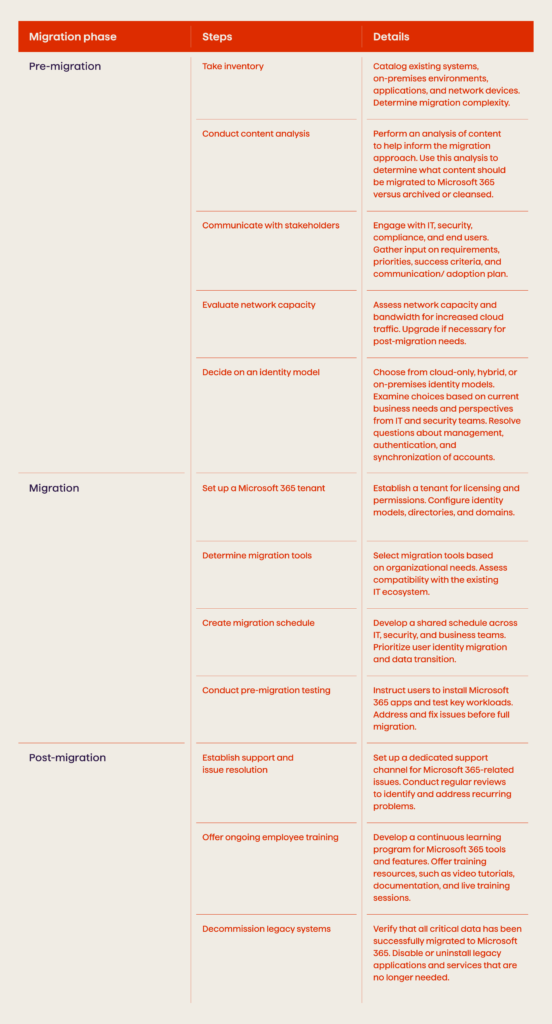Microsoft 365 Migration Checklist: Roadmap To A Smooth Transition

May 7, 2025 11 min read
A bird’s eye view of the complex migration processes.
Over the years, Microsoft 365 has gained a reputation as one of the most widely used productivity suites for businesses, with over 345 million monthly commercial users as of late 2022. And, despite massive shifts in the nature of work, transitioning to Microsoft 365 remains critical for organizations that want to create a flexible and collaborative digital environment for their employees. Such a transition of enterprise systems and data to this suite often comes with valid questions about planning and execution. That’s why, in this article, we will discuss essential points within the Microsoft 365 migration checklist and examine each stage of the process, from preparation to post-migration.
Roadmap To A Microsoft 365 Migration
An effective migration to Microsoft 365 leans on a well-thought-out strategy and execution across three key stages: preparation, migration, and post-migration. Technical migration is only half the journey. Cross-department coordination focused on driving user adoption within a secure governance framework is equally essential. With collaboration between IT teams and business leaders, organizations can fully leverage Microsoft 365’s capabilities. Consult this migration checklist to set coordinated milestones across security, infrastructure, and company culture as you thoughtfully switch to a new ecosystem:

With the strategy set up correctly, the technical preparations and execution plan can commence. Let’s take a closer look at each of these steps to better grasp the bigger picture of the processes within the migration.
Pre-Migration Checklist
While on a migration journey, a company can start with big-picture planning and the alignment of the stakeholders’ vision. It typically implies forming a cross-functional migration team, including IT leaders, end-users from each business unit, and project management support. Later, you can audit your existing systems and data storage to quantify users, products, data volumes, integrations with other systems, networking dependencies, and custom applications. Other essential steps are the following:
- Take inventory. Catalog servers, software, and databases, as well as SaaS apps, networking equipment, and security tools. Note which systems integrate with the Microsoft 365 capabilities you intend to deploy, including Exchange, SharePoint, Teams, or OneDrive. Quantify users, data volume, and network traffic to appropriately size your cloud tenant. This inventory lets a team classify the migration complexity for planning phases and technical work. Importantly, identify which applications are on-premises vs. SaaS, as the migration approach will differ. SaaS applications may only require an identity provider change, if supported, while on-premises apps will need to be migrated or re-architected to work with Microsoft 365. Focus the inventory specifically on:
- Number, size, and type of Exchange mailboxes that will migrate to Exchange Online
- Information in file storage locations and the files’ size/quantity for SharePoint Online migration
- Current meeting and messaging systems that will be replaced by Teams
- Custom applications and integrations
- Websites that may need to move to SharePoint Online or integrate with Azure AD for identity
- Conduct content analysis. Go through the quantified data, files, and email mailboxes cataloged in the inventory and deduplicate across systems. Detect duplicate content that exists in multiple silos that can be removed before migrating, reducing data volumes. Identify content that should be migrated to Microsoft 365 versus archived or stored elsewhere, since certain data may not need to sit at the highest tier. Perform an Active Directory cleanup before synchronization with Azure AD during tenant configuration. Remove inactive user accounts, duplicate accounts, and other AD artifacts that no longer serve a business purpose.
- Communicate with stakeholders. Form a migration team with representatives across IT, security, compliance, legal, and different power users and/or application administrators. Hold discussions with them to gather perspectives on business priorities, use cases, governance needs, and timelines. Determine which migration tools and methods fit each data type. Agree on a training strategy for users based on their migration scope. Well-informed users who understand new workflows, tools, and policies can drive faster adoption across organizations through independent migration of personal data. Develop user personas linked to their workflows and feature usage. Lastly, identify adoption champions in each department who can help drive excitement and usage of the new tools after migration. They can offer support and advice to colleagues during and after the transition.
- Evaluate network capacity. Assess existing network bandwidth and latency across critical sites. Cloud migrations shift more traffic to the internet so that upgrades may be required, particularly for video conferencing, cloud storage syncing, or remote access from branch locations after launch.
- Decide on an identity model. Select either cloud-only, hybrid, or federated on-premises identity synchronization based on your current systems and direction. IT leads and security experts will map out permissions from legacy directories and craft new governance reflecting decentralized access.
It is also a great option to assess organizational readiness through user surveys and interviews to determine typical workflows and feature utilization. With this baseline understanding of your as-is ecosystem, the team can design the ideal to-be state based on business goals, then determine timelines with ample testing and training built in. Another necessary element comes with the solicitation of executive buy-in and budget for any additional tools or staffing required for a smooth transition.
Learn how Avenga tailored an intranet solution that reaches a 99,9% uptime. Success story
Migration Checklist
With infrastructure prepared and testing completed, it’s time to migrate production systems and data to Microsoft 365. It is usually achieved by using a phased rollout to specific groups at scheduled intervals. For example, your team can first migrate collaboration sites for the Marketing team to gauge the impact on network and productivity. Then, experts monitor their adoption and address issues like reconfiguring access permissions or providing additional training. Here are other vital actions your company can take down the road to guarantee that the migration goes smoothly:
- Set up a Microsoft 365 tenant. Once pre-migration planning has aligned with the ecosystem requirements, the IT team provisions a Microsoft 365 tenant, adding licenses based on user counts per service like Exchange Online and SharePoint. Multi-geo capabilities should be configured if data sovereignty or in-region performance is required across your global footprint. Adjust the tenant for data retention policies, conditional access policies, and third-party identity provider integration according to security and compliance goals.
- Configure identity management. Identity is the control plane for Microsoft 365 access and governance, so this configuration step carries extra weight. Select the account synchronization model and authentication methods that best align with the organization’s security standards.
- Determine migration tools. Vet Microsoft first-party tools like SharePoint Migration Tool or Exchange Hybrid Configuration Wizard against popular third-party utilities like MigrationWiz, SkyKick, or ShareGate to determine what fits best based upon workload priorities around mailboxes, SharePoint sites, or the Teams chat history. Utilize multiple tools, if needed, for diverse data types; no one-size-fits-all migration tool exists.
- Create a migration schedule. Plot a migration schedule across departments and employment types according to launch timing and validation testing periods. Phase priority users and more complicated data sets earlier to allow sufficient testing cycles and changes to adoption before the organizational rollout.
- Conduct pre-migration testing. Leverage early phases focused on smaller pilot groups to test migration technologies and processes. Verify permissions as well as end-user workflows in the new Microsoft 365 environment. Refine approaches before shifting terabytes of production data owned by entire departments.
After a successful pilot, you can expand the site migration to other business units in waves. Take the lessons learned from early groups and use them to smooth out the transition for each successive wave. A controlled phase-by-phase shift eliminates business risks and allows IT professionals to incrementally handle change rather than react to a company-wide disruption.
Post-Migration Checklist
In the months following the launch, the migration team shifts its focus to support user adoption even though additional data migrations may still occur in gradual waves. Undoubtedly, end-users need time to adjust day-to-day workflows in Microsoft Teams instead of, let’s say, Skype or SharePoint versus shared drives, or new Planner-based project boards rather than offline checklists. Below is a list of other vital things to consider after the larger bulk of the migration is accomplished:
- Establish support and issue resolution. Have IT teams on standby to provide support during the initial post-launch weeks at a minimum but ideally spanning several months. Many queries will be end-user adoption obstacles rather than outright defects. To address this, incorporate FAQs into help articles for self-service. Log any migration-related bugs, performance issues, or missing data to identify the root causes, i.e., is the problem on the source or the target side? Last but not least, acknowledge gaps in applications and business processes that will not be relevant anymore after the migration to Office 365.
- Assess options to remediate. For example, rebuild on Power Platform through Microsoft 365 data, re-engineer around out-of-box features on SharePoint, or integrate with SaaS substitutes. This pragmatic reuse and rebuild approach provides a reliable path over complete rewrites.
- Offer ongoing employee training. Continue training efforts through and beyond the launch milestone. Promote hands-on training tutorials and self-help documentation closer to individual departmental migration waves going live. Schedule periodic refresher sessions after launch to share power user tips and tricks along the journey. Include feedback into long-term change management plans and educational campaigns. Identify unofficial ‘power users’ within business units to nurture as champions embedded within the organizational fabric to provide peer coaching.
- Decommission legacy systems. When the post-migration stability criteria are met, develop a timeline to deactivate and clean up legacy platforms. Avoid overly aggressive targets, as maintaining some systems like Active Directory on-premises may be necessary for compliance or hybrid identity model reasons. Establish permanent redirects, archived emails, or expansion of data retention policies to maintain access to critical information after decommissioning.
Migrating business systems and data to Microsoft 365 introduces various technical and organizational considerations, from infrastructure audits and security planning to end-user training and post-go-live support. Between planning appropriate environments and potentially large-scale data transitions and driving the adoption of unfamiliar tools now accessible to the entire workforce, incumbent knowledge gaps frequently surface even in mature IT teams.
As a report by McKinsey highlights, top economic performers allocate special focus to digital transformation and digital technology. And rather than jeopardize business goals due to an underestimated complexity, numerous enterprises seek external experts. Technology partners, familiar with the real-world implementation nuances across the migration checklist, provide advisory services and bring vital in-house skillsets. Organizations that cooperate with qualified Microsoft 365 experts are set to thrive through and after the transition.
How Does Migration To Microsoft 365 Pay Off?
At its core, Microsoft 365 removes infrastructure constraints that shackle productivity. Features like cloud-based Office 365 apps, Exchange Online, SharePoint team sites, OneDrive, and Microsoft Teams converge formerly disjointed communication and content collaboration into hub experiences accessible from anywhere, on any device. Furthermore, it frees users from physical workstations and serves as a robust backbone for open yet secure access.
Migration to Microsoft 365 consolidates previously disconnected solutions into intuitive cloud services and configurable platforms. What may have started as makeshift collaboration tools or project-specific apps can graduate into enterprise-grade workflows, backed by security and reliability. Through Microsoft 365’s ever-expanding suite of capabilities, businesses can also incrementally scale systems from departmental experiments to cross-functional solutions without the challenges of on-premises servers or patchwork integration.
Measure Twice, Migrate Once
A transition to Microsoft 365 offers businesses a chance to bring an impactful operational transformation; not just on the level of infrastructure, but also in the way employees deal with processes and collaborate. The effectiveness of the migration highly depends upon the initial analysis and planning phases. On top of that, meaningful change needs engagement from IT teams modernizing delivery models as much as from user communities primed for new ways to drive productivity and teamwork. With a sound technical deployment and strategic adoption initiatives, migration opens up new vistas for the digital transformation of the company. This is a place where advanced technologies amplify individual and collective potential rather than inhibit it behind legacy barriers.
Level up your digital transformation journey with Avenga: contact us.






